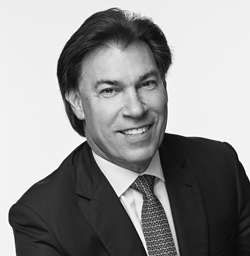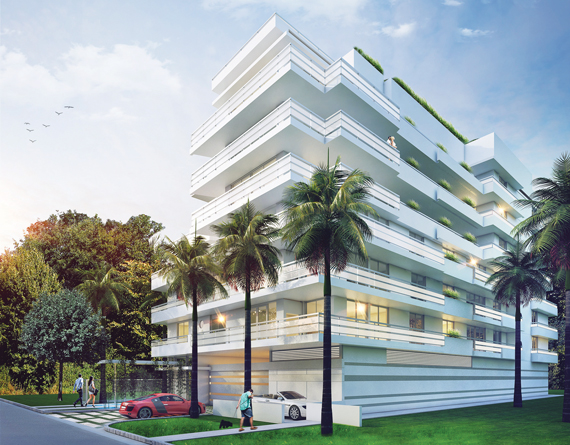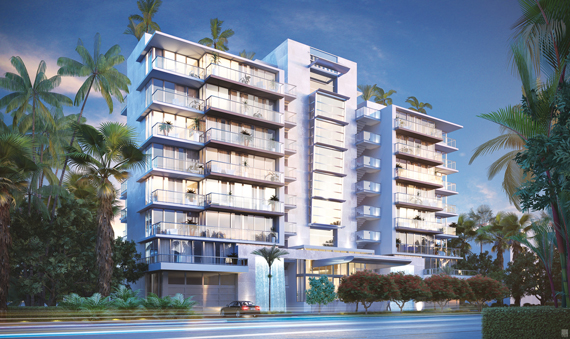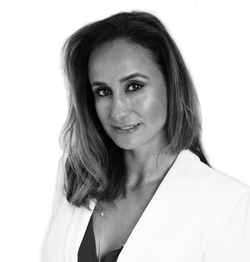In early February, Fortune International Group founder and CEO Edgardo DeFortuna and Chateau Group principal Manuel Grosskopf jetted to Toronto, where they met with Canadian real estate brokers and interested buyers inside the city’s Ritz-Carlton hotel. While giving their audience a briefing on the state of the Miami real estate market, DeFortuna and Grosskopf pitched the Ritz-Carlton Residences in Sunny Isles Beach, one of two high-end condo projects their companies are co-building in the northern Miami-Dade oceanside enclave.
“Right now, the Canadian buyer, especially in Toronto, finds Miami very attractive,” DeFortuna told The Real Deal. “We met with people who are followers of the Ritz-Carlton brand and are really interested in acquiring properties in Miami. One of the Toronto brokers aligned with us has purchased a unit himself, giving a lot of credibility to the project and the Miami market.”
Over the last 12 months, as buyers from Latin American countries remain on the sidelines due to plummeting exchange rates, Miami realtors and developers of luxury condos have sought to lure more buyers from Canada and the Northeastern U.S. Historically, such buyers typically gravitate north of the Miami-Dade county line, where prices for homes near or on the water are less expensive.
At the same time, sales at luxury condo projects in Hollywood and Fort Lauderdale are holding steady against the intensifying competition from south of Broward by increasing efforts to court international buyers looking for Miami-style towers at prices they can still afford.

Edgardo DeFortuna
“Obviously, there is always some competition between both markets,” DeFortuna said. “It’s getting bigger now that the pool of buyers is smaller, is aware of what is going on and is going to shop around. Certainly, the Northeasterner is looking at Fort Lauderdale and Miami and comparing both.”
Pursuing buyers from the Great White North makes sense. In 2016, Canadians represented 18.9 percent of Florida’s international-buyers market, surging from 11.1 percent the previous year, according to a recent annual report by the National Association of Realtors. The rest of the international-buyers market continues to drag.
“Slower economic growth in many countries, the strengthening of the dollar against most currencies, and rising prices due to lack of homes being sold on the market created a more challenging environment for foreign homebuyers,” the 2016 report stated.
For instance, Venezuelans accounted for only 7.8 percent of Florida’s major foreign buyers last year, compared with 18.4 percent in 2015. Venezuelans and Canadians, along with Argentinians, Brazilians and Brits made up a combined 48 percent of Florida’s foreign buyers.
In Florida, the slumping international market has a much greater impact than in the rest of the U.S. According to the National Association of Realtors’ report, foreigners account for 19 percent of the state’s residential market, of which 52 percent is concentrated in the Miami-Fort Lauderdale-West Palm Beach area. Nationally, the figure is seven percent.
Sales of residential properties to foreigners decreased by 18 percent to $19.4 billion in 2016, compared with the previous year, according to the report, which covered the 12-month period between August 2015 and July of last year. The price points on residential sales to foreigners also plummeted as developers slashed prices to move units. In 2015, a foreign buyer paid an average of $539,000 for a Florida property. Last year, the average price dropped to $412,000.
Because of currency devaluation, an Argentine investor looking to buy luxury real estate in South Florida can expect to pay 403 percent more today than in 2007 — that’s how much value the Argentine peso has lost against the dollar, according to Esslinger Wooten Maxwell’s 2017 South Florida Real Estate Market report. Similarly, a Venezuelan buyer would likely have to pay 365 percent more today than in 2007, and a Russian buyer would have to shell out 149 percent more.

Pearl House in Bay Harbor Islands
The declining number of foreign buyers has helped contribute to a glut of inventory. In the fourth quarter of 2016, the number of available condos priced at $1 million or more skyrocketed 69 percent compared with the same period the previous year, according to the EWM report. In Broward, the available inventory rose by 34 percent. Miami-Dade has a 58-month supply of inventory priced between $2 million and $4.9 million, and Broward County has a 76-month supply, according to the same report.
“These are very real numbers,” Ron Shuffield, EWM’s president and CEO, told a gathering of real estate professionals during a February presentation of his firm’s findings. “There is a lot of inventory and very few buyers.”
As a result, some Miami luxury real estate brokers are further focusing their efforts by increasingly promoting boutique condo projects in smaller cities like Aventura and Bay Harbor Islands to both domestic and Canadian buyers.
Hector Silva, a sales associate with Related ISG International Realty, recently shifted from marketing big projects such as Paraiso Bay in Edgewater and SLS Brickell to a smaller, boutique condo and townhouse development called Weitzer Aventura Place. Developed by South Florida residential community developer Harry Weitzer, the project comprises 82 units in six low-rise buildings; units go for between $282,000 and $490,000.
“The way the currency exchange has been the past 18 months, people can just afford less,” Silva said. “I started getting a lot of requests for products at lower price points than what I was selling, which was averaging a $1 million.”

Bijou Bay Harbor
Silva says he is reaching out to brokers in Fort Lauderdale and Weston to pitch Weitzer Aventura Place to their clientele. “I definitely think the Fort Lauderdale type of buyers are primed for something like this,” he said. “They have one foot in Broward and one foot in Miami-Dade.”
Liza Hernandez, sales director for Bijou Bay Harbor in Bay Harbor Islands, agreed that Miami developers and brokers are targeting domestic buyers from the Northeastern U.S. who normally explore Broward. “However, not all projects are suited to that demographic,” said Hernandez, who previously sold units at the more urban Paramount Miami WorldCenter. “I was in a large project in downtown Miami that tried to do that. It just isn’t a fit,” Hernandez said. “[Northeasterners] are looking for what Florida has to offer, which means tropical, waterfront and easy access to the beaches. They want fun in the sun.”
Bijou Bay Harbor, which is more than 60 percent sold, is a nine-story project located in a waterfront enclave, with 41 luxury residences that start at $585,000. “A buyer from the Northeast would pick Bal Harbour, Bay Harbor and Surfside before they pick anything more south,” she said. “They also want to move to places where more people speak English than Spanish.”
Hernandez said she has witnessed the intensifying competition from brokers marketing Miami to buyers who normally gravitate to Broward. “I see realtors that are now focusing on Canada and the Northeast,” she said. “I have more realtors who deal with local buyers than I see at other projects.” Realtors are spending money on advertising and marketing in Boston and Philadelphia publications, she added. “It’s a healthy competition.”
John Warsing, sales director for Verzasca Group, a Russian development firm building Aurora, a 61-unit boutique project in Sunny Isles Beach, and the 30-unit Le Jardin Residences and 15-unit Pearl House in Bay Harbor Islands, said he is also seeing more competition between the Miami and Fort Lauderdale markets. “The buyer looking to buy in Hollywood and Fort Lauderdale is also definitely shopping Bay Harbor, Bal Harbour and Sunny Isles Beach,” Warsing said. “Brokers are letting those buyers know what is available south of the Broward County line.”
Yet luxury projects in Fort Lauderdale seem to be holding their ground against Miami-Dade developers and brokers looking to poach buyers. DeFortuna, whose company also provides brokerage services, said The Related Group’s Auberge Beach Residences project in Fort Lauderdale is doing very well.
“The Auberge resort project has all the amenities and design that some of the luxury Miami projects have,” DeFortuna said. “Between December and January, we sold $54 million in units. It is a Fort Lauderdale oceanfront project that is outselling Miami projects.”

Peggy Fucci
Still, some real estate professionals claimed talk of increased competition between Miami and Fort Lauderdale is overblown. Peggy Fucci, CEO of OneWorld Properties, which handles sales for Paramount Miami Worldcenter and Paramount Fort Lauderdale Beach, said her team specifically targets domestic buyers for the Broward project and international buyers for the Miami tower.
“If I have a buyer interested in Miami Worldcenter, I will not offer them Paramount Fort Lauderdale,” Fucci said. “It is a market that doesn’t compete with Miami.”
Fucci, who has been doing business in Broward for 10 years, argued that the buyer looking at purchasing a home in the Fort Lauderdale market is not typically interested in seeing a Miami condo. “In Fort Lauderdale, the homebuyer is usually an empty nester and 80 percent of the time is local,” Fucci said. “They are either downsizing from a single-family home or looking to upgrade their condo. Or they are from the Northeast or Midwest and see Fort Lauderdale as a second home.”
In Miami, projects are geared to the international buyer who wants to invest their money in real estate they can flip for a profit or use for rental income, Fucci said. “At Paramount Fort Lauderdale, we don’t have investor buyers,” she said. “We are getting people who want to upgrade because it’s one of the newest condo towers built in the last 10 years.”
She also boasted that her sales team doesn’t need to pursue domestic buyers for Paramount Miami Worldcenter because the project is still selling units at a steady pace to foreigners. “Brazil continues to be our number one market,” Fucci said. “China is another very important market. I was there five times last year.”
Jay Parker, Douglas Elliman’s Florida brokerage CEO, echoed Fucci’s comments. “The constitution of the Broward market tends to be more domestic in nature, and Miami has not been much of a draw for them,” Parker said. “I don’t believe there is a heated competition between those respective markets.”
Parker also doesn’t see an influx of foreign buyers gravitating to Fort Lauderdale because prices are less expensive than in Miami; he thinks it’s because the Broward market has generally become more attractive. “We have seen a relatively rapid evolution and upgrade of the Broward County condo market in the last 24 months,” he said.
He also noted Douglas Elliman has strict rules in both markets forbidding brokers from pitching projects outside of their coverage areas. “We work very, very hard to be very militant about keeping our agents focused on their respective markets,” Parker said. “If there is an opportunity in another market, we encourage them to refer clients to a broker in that other market.”
Moreover, Parker said, condo sales to international buyers are going to pick up in 2017, even with the tough immigration policies emanating from the Trump White House. “I believe we are in for a tremendous influx of foreign investment,” Parker said. “I’m already seeing it pick up in Argentina, France, Turkey and Russia.”
DeFortuna agreed. “We see continued interest in Miami from pretty much everywhere in the world,” he said. “The urgency to rush in and buy is not there, but people really still love Miami.”
